LINCOLN MKZ 2015 Owners Manual
Manufacturer: LINCOLN, Model Year: 2015, Model line: MKZ, Model: LINCOLN MKZ 2015Pages: 516, PDF Size: 4.48 MB
Page 191 of 516
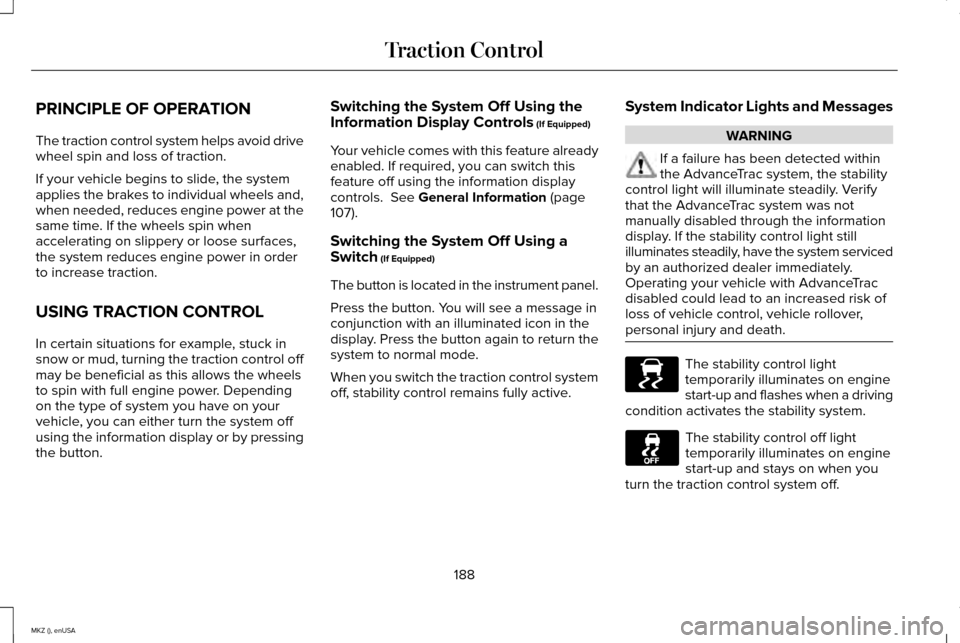
PRINCIPLE OF OPERATION
The traction control system helps avoid drive
wheel spin and loss of traction.
If your vehicle begins to slide, the system
applies the brakes to individual wheels and,
when needed, reduces engine power at the
same time. If the wheels spin when
accelerating on slippery or loose surfaces,
the system reduces engine power in order
to increase traction.
USING TRACTION CONTROL
In certain situations for example, stuck in
snow or mud, turning the traction control off
may be beneficial as this allows the wheels
to spin with full engine power. Depending
on the type of system you have on your
vehicle, you can either turn the system off
using the information display or by pressing
the button.
Switching the System Off Using the
Information Display Controls (If Equipped)
Your vehicle comes with this feature already
enabled. If required, you can switch this
feature off using the information display
controls.
See General Information (page
107).
Switching the System Off Using a
Switch
(If Equipped)
The button is located in the instrument panel.
Press the button. You will see a message in
conjunction with an illuminated icon in the
display. Press the button again to return the
system to normal mode.
When you switch the traction control system
off, stability control remains fully active. System Indicator Lights and Messages WARNING
If a failure has been detected within
the AdvanceTrac system, the stability
control light will illuminate steadily. Verify
that the AdvanceTrac system was not
manually disabled through the information
display. If the stability control light still
illuminates steadily, have the system serviced
by an authorized dealer immediately.
Operating your vehicle with AdvanceTrac
disabled could lead to an increased risk of
loss of vehicle control, vehicle rollover,
personal injury and death. The stability control light
temporarily illuminates on engine
start-up and flashes when a driving
condition activates the stability system. The stability control off light
temporarily illuminates on engine
start-up and stays on when you
turn the traction control system off.
188
MKZ (), enUSA Traction ControlE138639
Page 192 of 516
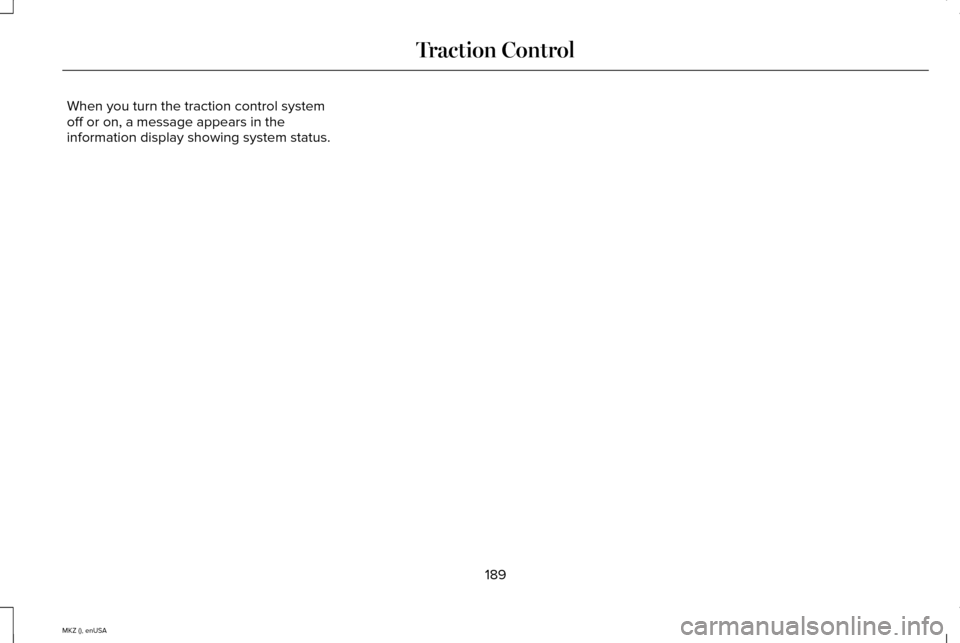
When you turn the traction control system
off or on, a message appears in the
information display showing system status.
189
MKZ (), enUSA Traction Control
Page 193 of 516
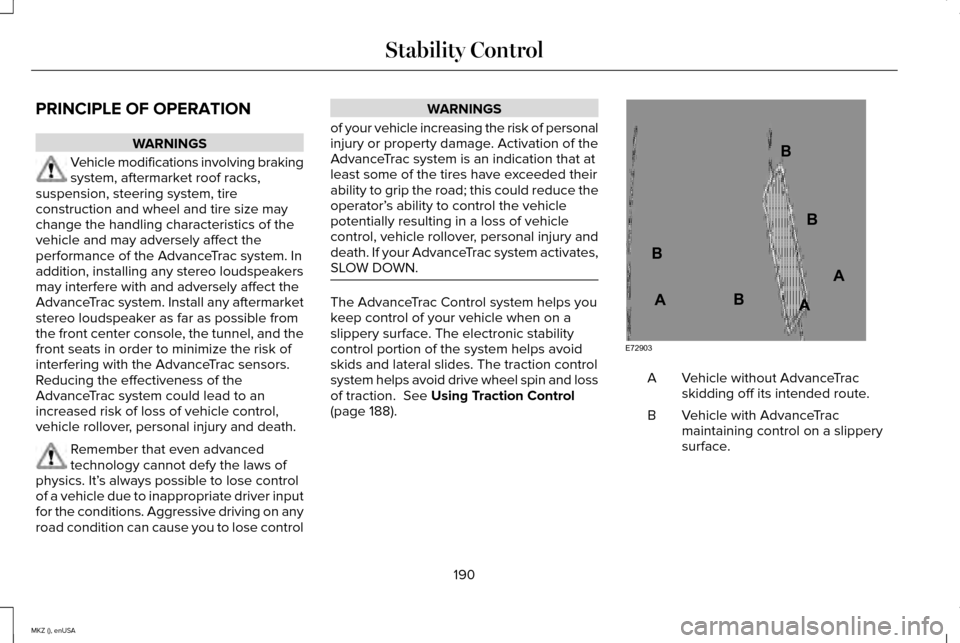
PRINCIPLE OF OPERATION
WARNINGS
Vehicle modifications involving braking
system, aftermarket roof racks,
suspension, steering system, tire
construction and wheel and tire size may
change the handling characteristics of the
vehicle and may adversely affect the
performance of the AdvanceTrac system. In
addition, installing any stereo loudspeakers
may interfere with and adversely affect the
AdvanceTrac system. Install any aftermarket
stereo loudspeaker as far as possible from
the front center console, the tunnel, and the
front seats in order to minimize the risk of
interfering with the AdvanceTrac sensors.
Reducing the effectiveness of the
AdvanceTrac system could lead to an
increased risk of loss of vehicle control,
vehicle rollover, personal injury and death. Remember that even advanced
technology cannot defy the laws of
physics. It’ s always possible to lose control
of a vehicle due to inappropriate driver input
for the conditions. Aggressive driving on any
road condition can cause you to lose control WARNINGS
of your vehicle increasing the risk of personal
injury or property damage. Activation of the
AdvanceTrac system is an indication that at
least some of the tires have exceeded their
ability to grip the road; this could reduce the
operator’ s ability to control the vehicle
potentially resulting in a loss of vehicle
control, vehicle rollover, personal injury and
death. If your AdvanceTrac system activates,
SLOW DOWN. The AdvanceTrac Control system helps you
keep control of your vehicle when on a
slippery surface. The electronic stability
control portion of the system helps avoid
skids and lateral slides. The traction control
system helps avoid drive wheel spin and loss
of traction. See Using Traction Control
(page 188). Vehicle without AdvanceTrac
skidding off its intended route.
A
Vehicle with AdvanceTrac
maintaining control on a slippery
surface.
B
190
MKZ (), enUSA Stability ControlE72903A
AA
B
BB
B
Page 194 of 516
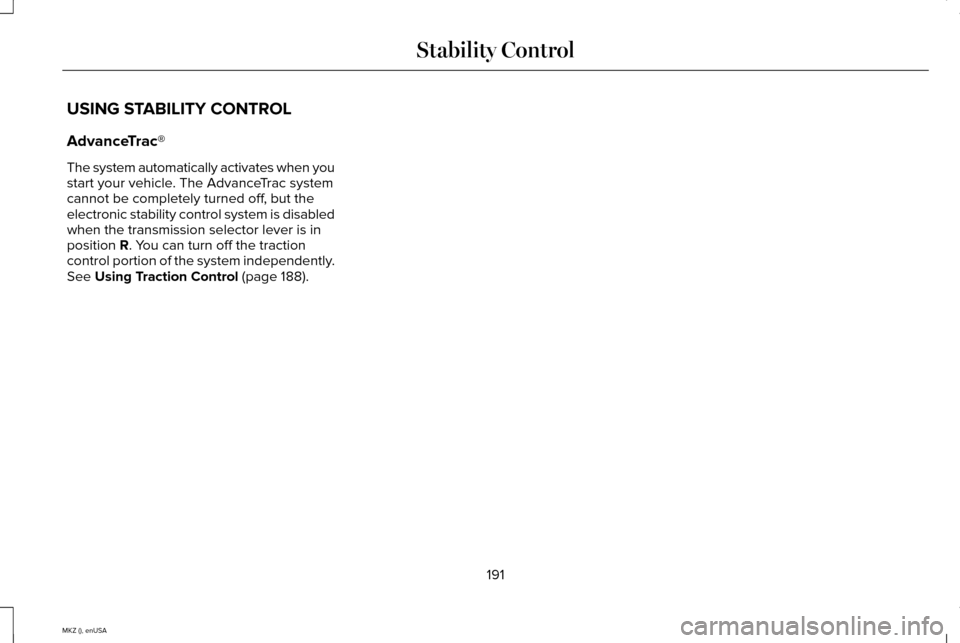
USING STABILITY CONTROL
AdvanceTrac®
The system automatically activates when you
start your vehicle. The AdvanceTrac system
cannot be completely turned off, but the
electronic stability control system is disabled
when the transmission selector lever is in
position R. You can turn off the traction
control portion of the system independently.
See
Using Traction Control (page 188).
191
MKZ (), enUSA Stability Control
Page 195 of 516
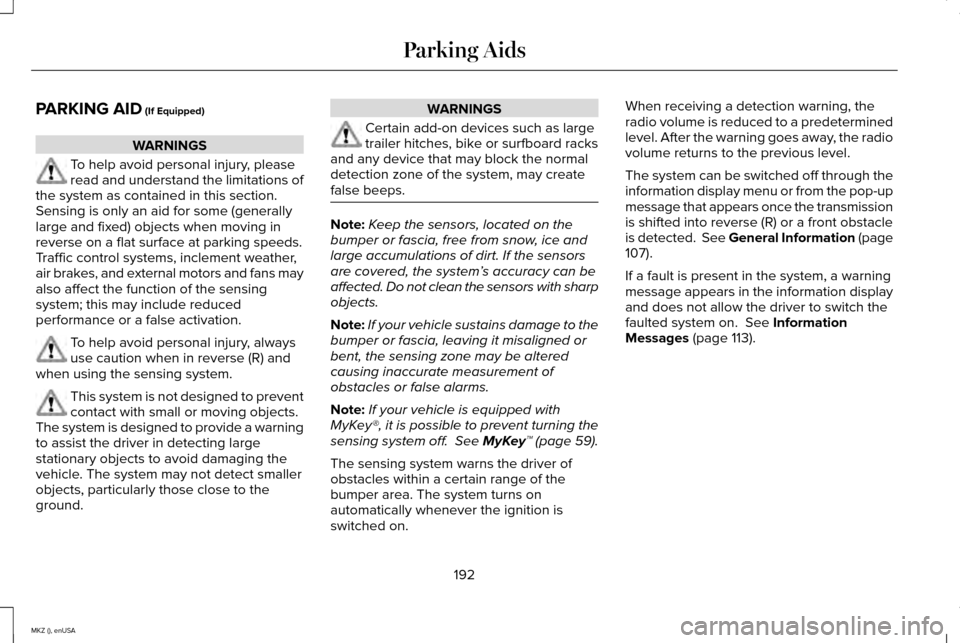
PARKING AID (If Equipped)
WARNINGS
To help avoid personal injury, please
read and understand the limitations of
the system as contained in this section.
Sensing is only an aid for some (generally
large and fixed) objects when moving in
reverse on a flat surface at parking speeds.
Traffic control systems, inclement weather,
air brakes, and external motors and fans may
also affect the function of the sensing
system; this may include reduced
performance or a false activation. To help avoid personal injury, always
use caution when in reverse (R) and
when using the sensing system. This system is not designed to prevent
contact with small or moving objects.
The system is designed to provide a warning
to assist the driver in detecting large
stationary objects to avoid damaging the
vehicle. The system may not detect smaller
objects, particularly those close to the
ground. WARNINGS
Certain add-on devices such as large
trailer hitches, bike or surfboard racks
and any device that may block the normal
detection zone of the system, may create
false beeps. Note:
Keep the sensors, located on the
bumper or fascia, free from snow, ice and
large accumulations of dirt. If the sensors
are covered, the system’ s accuracy can be
affected. Do not clean the sensors with sharp
objects.
Note: If your vehicle sustains damage to the
bumper or fascia, leaving it misaligned or
bent, the sensing zone may be altered
causing inaccurate measurement of
obstacles or false alarms.
Note: If your vehicle is equipped with
MyKey®, it is possible to prevent turning the
sensing system off. See MyKey™ (page 59).
The sensing system warns the driver of
obstacles within a certain range of the
bumper area. The system turns on
automatically whenever the ignition is
switched on. When receiving a detection warning, the
radio volume is reduced to a predetermined
level. After the warning goes away, the radio
volume returns to the previous level.
The system can be switched off through the
information display menu or from the pop-up
message that appears once the transmission
is shifted into reverse (R) or a front obstacle
is detected. See General Information (page
107
).
If a fault is present in the system, a warning
message appears in the information display
and does not allow the driver to switch the
faulted system on.
See Information
Messages (page 113).
192
MKZ (), enUSA Parking Aids
Page 196 of 516
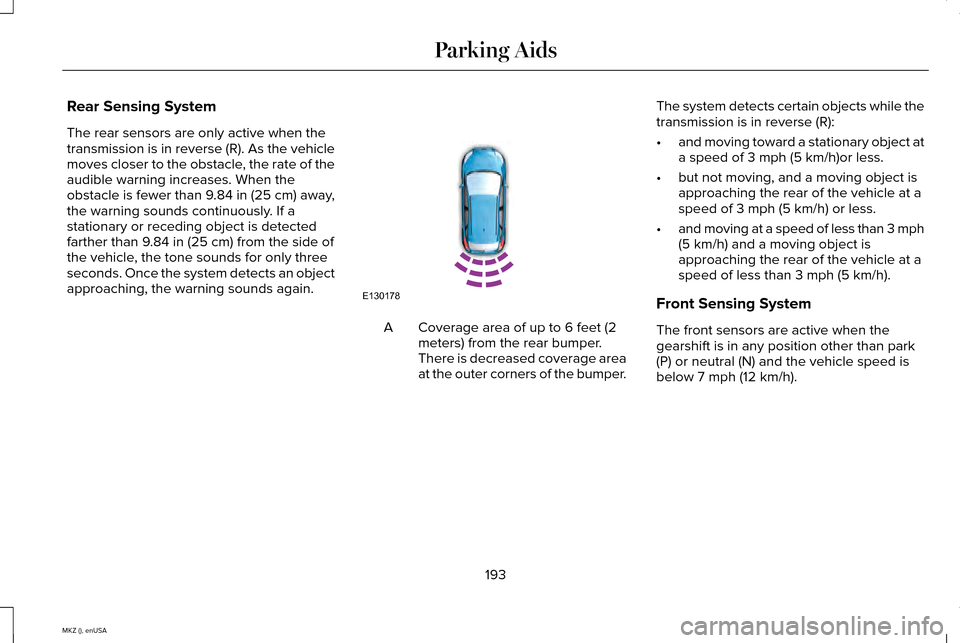
Rear Sensing System
The rear sensors are only active when the
transmission is in reverse (R). As the vehicle
moves closer to the obstacle, the rate of the
audible warning increases. When the
obstacle is fewer than 9.84 in (25 cm) away,
the warning sounds continuously. If a
stationary or receding object is detected
farther than 9.84 in (25 cm) from the side of
the vehicle, the tone sounds for only three
seconds. Once the system detects an object
approaching, the warning sounds again. Coverage area of up to 6 feet (2
meters) from the rear bumper.
There is decreased coverage area
at the outer corners of the bumper.
A The system detects certain objects while the
transmission is in reverse (R):
•
and moving toward a stationary object at
a speed of
3 mph (5 km/h)or less.
• but not moving, and a moving object is
approaching the rear of the vehicle at a
speed of 3 mph (5 km/h) or less.
• and moving at a speed of less than 3 mph
(5 km/h)
and a moving object is
approaching the rear of the vehicle at a
speed of less than
3 mph (5 km/h).
Front Sensing System
The front sensors are active when the
gearshift is in any position other than park
(P) or neutral (N) and the vehicle speed is
below
7 mph (12 km/h).
193
MKZ (), enUSA Parking AidsE130178
Page 197 of 516
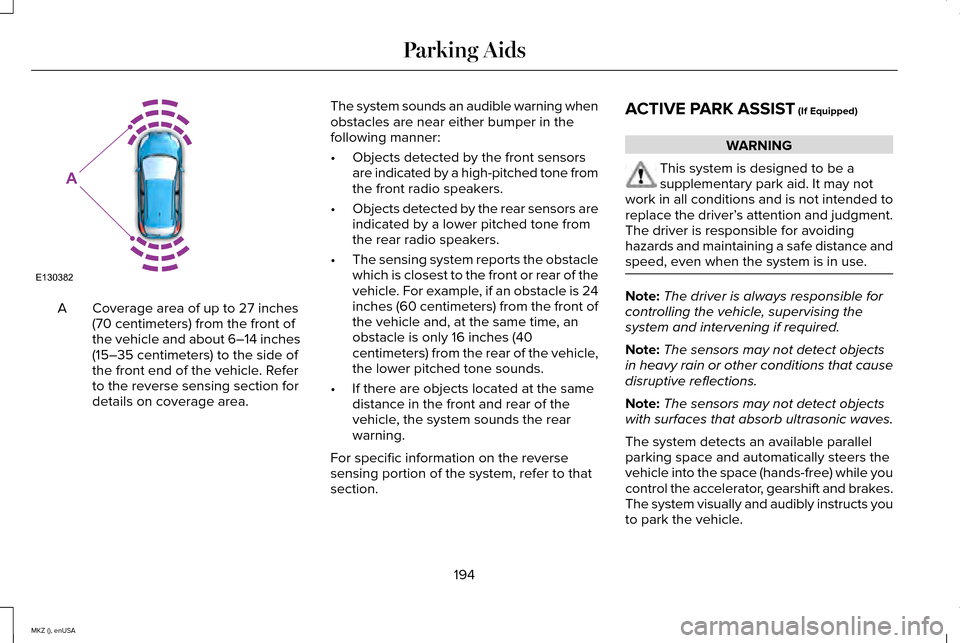
Coverage area of up to 27 inches
(70 centimeters) from the front of
the vehicle and about 6–14 inches
(15–35 centimeters) to the side of
the front end of the vehicle. Refer
to the reverse sensing section for
details on coverage area.
A The system sounds an audible warning when
obstacles are near either bumper in the
following manner:
•
Objects detected by the front sensors
are indicated by a high-pitched tone from
the front radio speakers.
• Objects detected by the rear sensors are
indicated by a lower pitched tone from
the rear radio speakers.
• The sensing system reports the obstacle
which is closest to the front or rear of the
vehicle. For example, if an obstacle is 24
inches (60 centimeters) from the front of
the vehicle and, at the same time, an
obstacle is only 16 inches (40
centimeters) from the rear of the vehicle,
the lower pitched tone sounds.
• If there are objects located at the same
distance in the front and rear of the
vehicle, the system sounds the rear
warning.
For specific information on the reverse
sensing portion of the system, refer to that
section. ACTIVE PARK ASSIST (If Equipped) WARNING
This system is designed to be a
supplementary park aid. It may not
work in all conditions and is not intended to
replace the driver’ s attention and judgment.
The driver is responsible for avoiding
hazards and maintaining a safe distance and
speed, even when the system is in use. Note:
The driver is always responsible for
controlling the vehicle, supervising the
system and intervening if required.
Note: The sensors may not detect objects
in heavy rain or other conditions that cause
disruptive reflections.
Note: The sensors may not detect objects
with surfaces that absorb ultrasonic waves.
The system detects an available parallel
parking space and automatically steers the
vehicle into the space (hands-free) while you
control the accelerator, gearshift and brakes.
The system visually and audibly instructs you
to park the vehicle.
194
MKZ (), enUSA Parking AidsE130382
A
Page 198 of 516
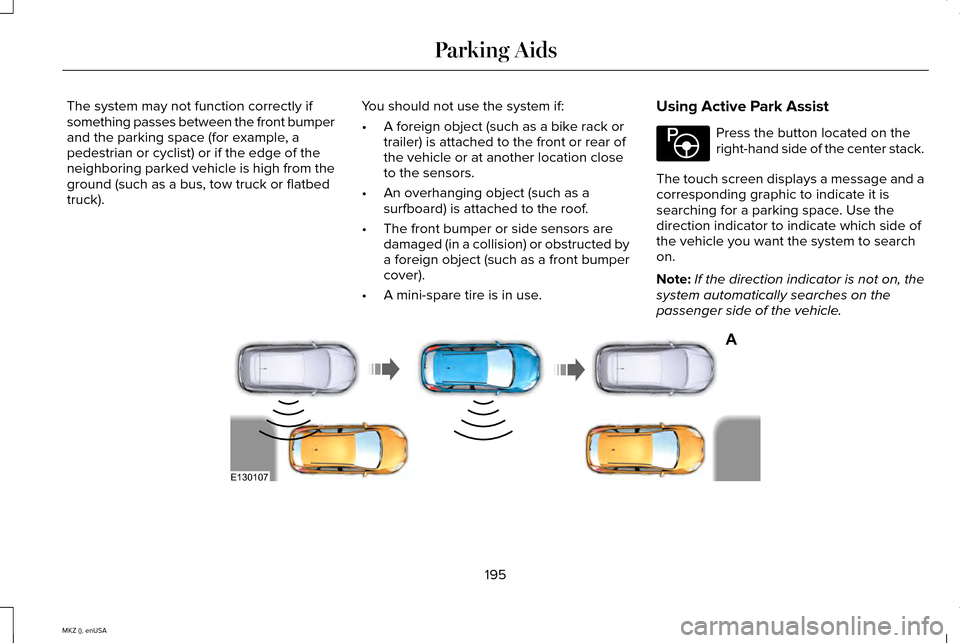
The system may not function correctly if
something passes between the front bumper
and the parking space (for example, a
pedestrian or cyclist) or if the edge of the
neighboring parked vehicle is high from the
ground (such as a bus, tow truck or flatbed
truck).
You should not use the system if:
•
A foreign object (such as a bike rack or
trailer) is attached to the front or rear of
the vehicle or at another location close
to the sensors.
• An overhanging object (such as a
surfboard) is attached to the roof.
• The front bumper or side sensors are
damaged (in a collision) or obstructed by
a foreign object (such as a front bumper
cover).
• A mini-spare tire is in use. Using Active Park Assist Press the button located on the
right-hand side of the center stack.
The touch screen displays a message and a
corresponding graphic to indicate it is
searching for a parking space. Use the
direction indicator to indicate which side of
the vehicle you want the system to search
on.
Note: If the direction indicator is not on, the
system automatically searches on the
passenger side of the vehicle. 195
MKZ (), enUSA Parking AidsE146186 A
E130107
Page 199 of 516
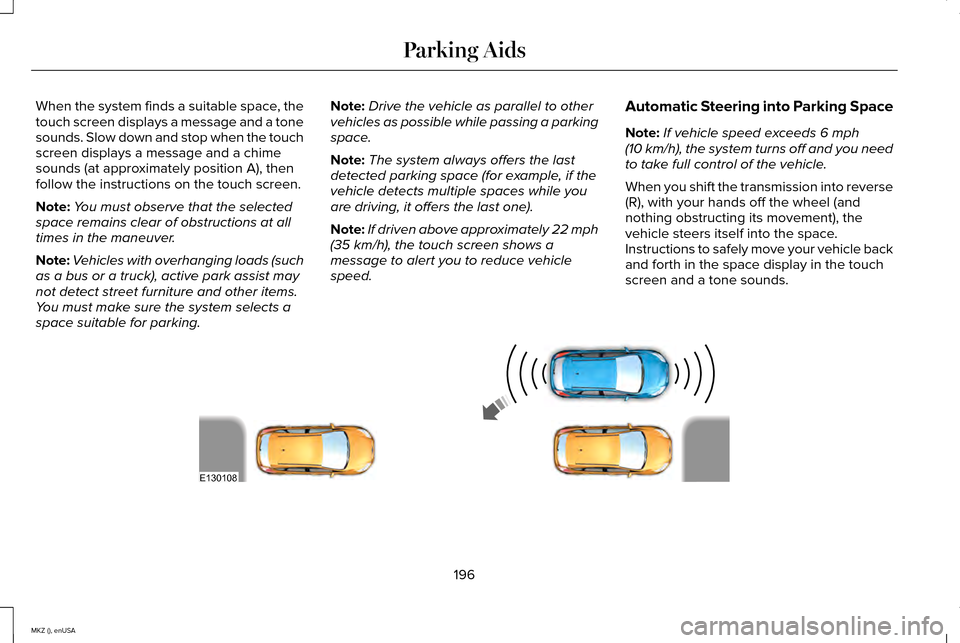
When the system finds a suitable space, the
touch screen displays a message and a tone
sounds. Slow down and stop when the touch
screen displays a message and a chime
sounds (at approximately position A), then
follow the instructions on the touch screen.
Note:
You must observe that the selected
space remains clear of obstructions at all
times in the maneuver.
Note: Vehicles with overhanging loads (such
as a bus or a truck), active park assist may
not detect street furniture and other items.
You must make sure the system selects a
space suitable for parking. Note:
Drive the vehicle as parallel to other
vehicles as possible while passing a parking
space.
Note: The system always offers the last
detected parking space (for example, if the
vehicle detects multiple spaces while you
are driving, it offers the last one).
Note: If driven above approximately 22 mph
(35 km/h), the touch screen shows a
message to alert you to reduce vehicle
speed. Automatic Steering into Parking Space
Note:
If vehicle speed exceeds
6 mph
(10 km/h), the system turns off and you need
to take full control of the vehicle.
When you shift the transmission into reverse
(R), with your hands off the wheel (and
nothing obstructing its movement), the
vehicle steers itself into the space.
Instructions to safely move your vehicle back
and forth in the space display in the touch
screen and a tone sounds. 196
MKZ (), enUSA Parking AidsE130108
Page 200 of 516
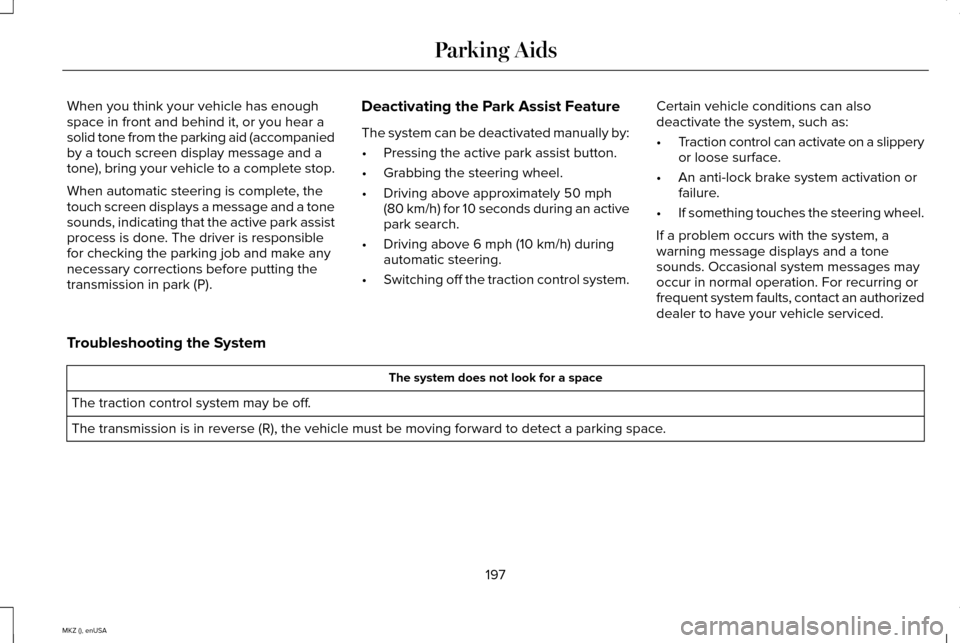
When you think your vehicle has enough
space in front and behind it, or you hear a
solid tone from the parking aid (accompanied
by a touch screen display message and a
tone), bring your vehicle to a complete stop.
When automatic steering is complete, the
touch screen displays a message and a tone
sounds, indicating that the active park assist
process is done. The driver is responsible
for checking the parking job and make any
necessary corrections before putting the
transmission in park (P).
Deactivating the Park Assist Feature
The system can be deactivated manually by:
•
Pressing the active park assist button.
• Grabbing the steering wheel.
• Driving above approximately 50 mph
(80 km/h) for 10 seconds during an active
park search.
• Driving above
6 mph (10 km/h) during
automatic steering.
• Switching off the traction control system. Certain vehicle conditions can also
deactivate the system, such as:
•
Traction control can activate on a slippery
or loose surface.
• An anti-lock brake system activation or
failure.
• If something touches the steering wheel.
If a problem occurs with the system, a
warning message displays and a tone
sounds. Occasional system messages may
occur in normal operation. For recurring or
frequent system faults, contact an authorized
dealer to have your vehicle serviced.
Troubleshooting the System The system does not look for a space
The traction control system may be off.
The transmission is in reverse (R), the vehicle must be moving forward\
to detect a parking space.
197
MKZ (), enUSA Parking Aids